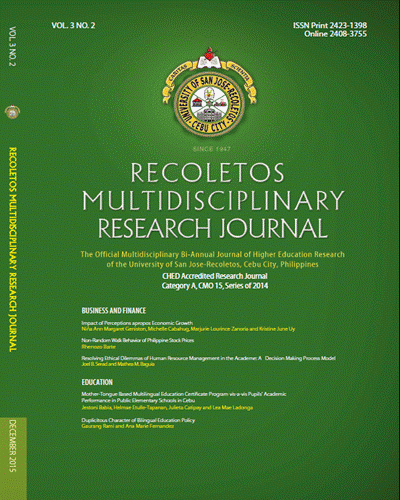ASEAN Integration: The Domination and Subordination among Member Nations
DOI:
https://doi.org/10.32871/rmrj1503.02.06Keywords:
ASEAN integration, competition, cooperation, economic disparity, regional cooperationAbstract
The ASEAN from its original purpose of conception has evolved into what it is envisioned now of integrating the 10 individual economies into a single regional economy. Its traditional practice of consensus and consultation poses a challenge and as a factor in lagging behind the development of its implementation. But what state from among the ten members is the best candidate to lead the organization remained to be a question. This research explores the possibility of determining the potential leader of the organization by considering several variables like corruption perception index, global competitiveness, government effectiveness, GNI, etc. and utilized the process known as exploratory data analysis or data mining in gathering data. Data gathered were then processed through the use of statistical software to cluster the variables. Cluster analysis was then performed to establish relevant relationships, similarities, or differences of the data collected. Results and data gathered from several relevant studies about the topic were also collectively analyzed to determine the gap of perspectives from other notable scholars and to gain new insights to fill in that gap. Based on this method of analysis, it was revealed that there’s a single country that stands out from the rest and is the best candidate to lead the ASEAN Integration. A new paradigm shift is beginning to surface from collective to a single leadership.
References
All reports on “Asia Pacific Roundtable 1999†by,Anis Kamil, & Singh, P. (1999, Jun 02). Don: Lack of leadership a factor in diminished standing of asean. New Straits Times Retrieved from http://search.proquest.com/docview/266495650?accountid=33262
Allen, K. (2015, Feb 01). Business: GDP: WHAT IT IS – AND WHAT IT IS NOT. The Observer retrieved from http://search.proquest.com/docview/1650031519?=33262
Areethamsirikul, S. (2008). The impact of ASEAN enlargement on economic integration: Successes and impediments under ASEAN political institution (Order No. 3314276). Available from ProQuest Central. (304450946). Retrieved from http://search.proquest.com/docview/304450946?accountid=33262
Ba, A. (1997). The ASEAN regional forum: Maintaining the regional idea in southeast asia. International Journal, 52(4), 635. Retrieved from http://search.proquest.com/docview/220855673?accountid=33262
BANGKOK POST: REGIONAL PROBLEMS: Can the regional grouping of southeast asian nations reform itself in time to avoid obsolesence?: Asean’s identity crisis. (2000, Sep 28). The Bangkok Post Retrieved from http://search.proquest.com/docview/308770187?accountid=33262
Bayuni, E. (2007, Aug 08). It’s time to question ASEAN’s consensus model. The Jakarta Post Retrieved from http://ezproxy.usjr.edu.ph:2066/docview/288308315?accountid=33262
Bellman, E., & Vaughan, M. (2011, May 09). World news: Indonesia seeks larger role in asean. The Wall Street Journal Asia Retrieved from http://search.proquest.com/docview/865154111?accountid=33262
Blizkovsky, P. (2013). Economic governance: What can the EU and ASEAN learn from each other after the economic crises?Journal of Southeast Asian Economies, 30(1), 1-18. Retrieved from http://search.proquest.com/docview/1492268739?accountid=33262
Bretherton, C., & Vogler, J., (2006). The European Union as a global actor (2nd ed.). London: Routledge.
Caplen, B., & Ooi, G. T. (1991). Making the heirs apparent. Asian Business, 27(8), 24. Retrieved from http://search.proquest.com/docview/199850048?accountid=33262
Chongkittavorn, K. (2014, Jan 13). Is thailand ready for asean economic community? The Nation Retrieved from http://search.proquest.com/docview/1476910089?accountid=33262
Funston, J. (1999). Challenges facing ASEAN in a more complex age. Contemporary Southeast Asia, 21(2), 205-219. Retrieved from http://search.proquest.com/docview/205217303?accountid=33262
Grimm, M. (1992). Japan and ASEAN: A new interdependence. East Asian Executive Reports, 14(4), 11. Retrieved from http://search.proquest.com/docview/204135567?accountid=33262
Groff, S. P. (2014, June 23). Keynote speech: ASEAN integration and the private sector. Retrieved from https://www.adb.org/news/speeches/keynote-speech-asean-integration-and-private-sector-stephen-p-groff
Ho, B., Singh, B., & Teo, S. (2015). Malaysia’s ASEAN chairmanship in 2015: Perspectives and prospects. Washington: East - West Center. Retrieved from http://search.proquest.com/docview/1675989494?accountid=33262
Kim, M. (2011). Theorizing ASEAN integration. Asian Perspective, 35(3), 407-435. Retrieved from http://search.proquest.com/docview/928757491?accountid=33262
Magalhaes, P.C. (2014). Government effectiveness and support for democracy. European Journal of Political Research, 53(1), 77-97.Doi:http://dx.doi.org/10.1111/1475-6765.1204
Mattli, W. (1999). The logic of regional integration: Europe and beyond. Cambridge: Cambridge University Press.
Medalla, E. M. (2012). Managing the ASEAN economic integration process in the philippines: An assessment of progress in trade liberalization and facilitation. Philippine Journal of Development, 39(1), 1-21. Retrieved from http://search.proquest.com/docview/1550131110?accountid=33262
Morada, N. M. (2012). Europe and southeast asia: ASEAN-EU interregionalism between pluralist and solidarist societies. Review of European Studies, 4(3), 89-99. Retrieved from http://search.proquest.com/docview/1030094398?accountid=33262
News analysis: ASEAN faces challenges in achieving regional economic integration. (2014, Apr 16). Xinhua News Agency – CEIS Retrieved from http://search.proquest.com/docview/1516797354?accountid=33262
Nur Ashikin, A. A. (2015, Jan 07). JAPAN, CHINA CONFIDENT MALAYSIA CAN TAKE LEADING ROLE TO BOOST ASEAN UNITY.BERNAMA : Malaysian National News Agency Retrieved from http://search.proquest.com/docview/1643153931?accountid=33262
Nwosu, E. O., Orji, A., Urama, N., & Amuka, J. I. (2013). Regional integration and foreign investment: The case of asean countries. Asian Economic and Financial Review, 3(12), 1670-1680. Retrieved from http://search.proquest.com/docview/1534552183?accountid=33262
Oh, E. S. (2015, June 12). Latest Sino-Malaysian encounter amidst South China Sea disputes – Whither the shift in Malaysian reaction? TN News Retrieved from http://www.thanhniennews.com/commentaries/latest-sinomalaysian-encounter-amidst-south-china-sea-disputes-whither-the-shift-in-malaysian-reaction-46593.html
PH tech-voc education ready for ASEAN integration. (2014, Sep 07). The Philippines News Agency (PNA) Retrieved from http://search.proquest.com/docview/1560537507?accountid=33262
Philippines: RDC-9 holds ASEAN economic community forum. (2014, May 30). Asia News Monitor Retrieved from http://search.proquest.com/docview/1530385376?accountid=33262
Purba, K. (2002, Nov 11). ASEAN needs collective leadership. The Jakarta Post Retrieved from http://search.proquest.com/docview/288197352?accountid=33262
Rafi, B., & Lewis, P. (2012). Testing for the degree of economic integration in ASEAN. The Asia Pacific Journal of Economics & Business, 16(1), 51-63. Retrieved from
http://search.proquest.com/docview/1355715832?accountid=33262
Roberts, C. (2010, Dec 8). ASEAN institutionalisation: The function of political values and state capacity. RSIS Working Paper, (217).
Schwartz, A., & Villinger, R. (2004). Integrating Southeast Asian Economies. The McKinsey Quarterly, (1).
Smith, A. (1999). Indonesia’s role in ASEAN: The end of leadership? Contemporary Southeast Asia, 21(2), 238-260. Retrieved from http://search.proquest.com/docview/205217388?accountid=33262
Vatikiotis, M., & McBeth, J. (2003). A tango speeds asean integration. Far Eastern Economic Review, 166(42), 16-18. Retrieved from http://search.proquest.com/docview/208237434?accountid=33262
Wah, C. K. (2007). Introduction: ASEAN - facing the fifth decade. Contemporary Southeast Asia, 29(3), 395-405. Retrieved from http://search.proquest.com/docview/205221718?accountid=33262
Young, O. R. (1991). Political leadership and regime formation: On the development of institutions of international society. International Organizations, 45(3), 281-308.
Downloads
Published
How to Cite
Issue
Section
License
Copyright of the Journal belongs to the University of San Jose-Recoletos


